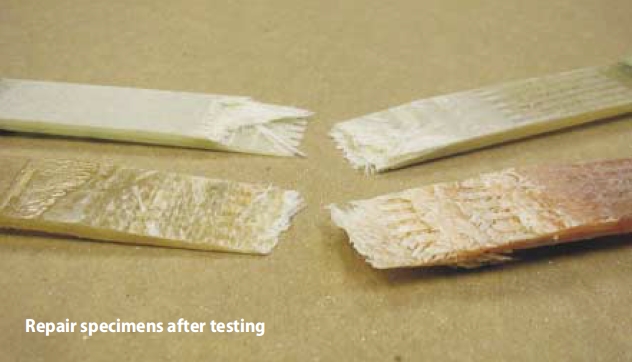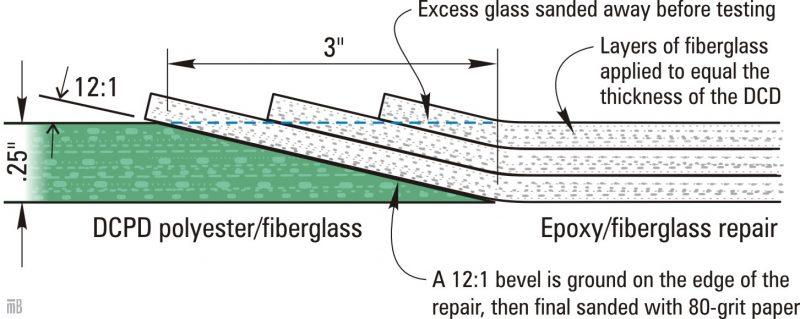
for Fiberglass Boat Repair
by Tom Pawlak — GBI Technical Advisor
Above: Epoxy vs. polyester in a typical fiberglass boat repair cross-section.
Even though we’ve been promoting the use of WEST SYSTEM® Epoxy for repairing fiberglass boats (boats made with polyester resin) in our manuals and Epoxyworks for many years, we continue to receive inquiries asking whether it is appropriate to use epoxy for polyester boat repair. Because of the misinformation still prevalent in marinas, local yacht clubs and on the Internet, we felt it was time to restate the case for epoxy.
A brief history
Before WEST SYSTEM epoxy came on the polyester boat repair scene in the mid 1980’s, most fiberglass boats were repaired with polyester resin. The repairs were typically successful if done by an experienced repairer. Thirty-five years ago, fiberglass boats were overbuilt by today’s standards. Many boats were built primarily with chopped strand fiberglass and polyester resin. Chopped strand fiberglass is not very strong compared to the woven fabrics and stitched oriented strand fabrics used more recently. However, hulls made with chopped strand fiberglass and polyester resin were built quite thick, which produced hulls that were very stiff and heavy. To repair these laminates, the technician would grind away damaged laminate and sand a gradual taper around the perimeter before laminating with new fiberglass and polyester resin. Acetone was often applied to the sanded area and was thought to soften the polyester resin and improve the bond between the existing laminate and the repair resin. Whether or not this improved the bond strength is debatable.
Polyester resin’s chemistry has changed over the years. Because many hulls are built thinner today and are more flexible, they are more difficult to repair effectively, especially with polyester resin. Laminates built with the new polyester are more difficult to repair because the resin cross-links more completely during cure. This means fewer bonding sites are available for primary bonds to form during a repair. A few boatbuilders using new polyester formulations are now glass tabbing in their bulkheads with epoxy instead of polyester resin. Because epoxies form superior secondary bonds, they do not have a problem adhering to properly prepared, cured polyester.
Comparing epoxy vs. polyester
Polyester resin and epoxy resins differ in a number of ways. Polyester resin (often referred to as boat resin) is still used today to build most production fiberglass boats because it is the lowest cost option for new construction when combined with fiberglass reinforcements. Polyester resin can be quite brittle so randomly oriented chopped strand fiberglass is typically used between layers of woven or stitched fabrics so loads can be effectively transferred between the structural fiberglass plies. Without the chopped strand, micro-cracks can develop over time in the resin between structural fiberglass layers.
Polyester resin is normally air-inhibited, which means it typically remains uncured (sticky or tacky) on the surface when exposed to air. To cure reliably, the general-purpose polyester resin needs to be applied in at least 15 to 25 mil (.015″ to .025″) thickness. It is not very effective as an adhesive (partially because it will not cure thoroughly in thin films) and is only marginally effective as a repair resin for repairing well-cured polyester/fiberglass laminates. Polyester resin is not recommended for repairing vinylester or epoxy laminates.
Epoxy is used very effectively as an adhesive, as a laminating resin for wetting out structural fabrics, and as a coating. It has excellent thin-film cure characteristics and resists micro-cracking better than polyester resin. WEST SYSTEM Epoxy offers 3.5% to 4.5% tensile elongation at failure compared to 1% to 2% for typical polyester resins. It offers excellent moisture barrier qualities when used as a coating. It adheres to many different substrates including wood, metals, cured polyester laminates, vinylester laminates, and epoxy laminates. It binds extremely well to graphite fibers, which is why it is often used for making high-strength graphite fiber composites.
Epoxy is more versatile
Polyester resin manufacturers recommend that their products be cured in temperatures above 60°F. Repair yards often have to work in much cooler conditions. Extra MEKP (methyl ethyl ketone peroxide) catalyst can be added to assist the cure in cool temperatures, but cured physical properties suffer because of it. The shelf life of general-purpose polyester resin is six months to a year from the time it is manufactured.
WEST SYSTEM Epoxy is routinely used to repair structural damage to fiberglass boats over a wide temperature range. Hardeners are available for curing it from 40°F on up. The shelf life of WEST SYSTEM Epoxy is several years.
Epoxy has fewer fumes
Fumes from polyester resin are quite strong and flammable. Fumes from WEST SYSTEM epoxy are slight in comparison and not a fire hazard. However, both polyester resin and epoxy are industrial chemicals and should be used with care.
Epoxy is stronger
We’ve compared epoxy vs. polyester and found the repair effectiveness of WEST SYSTEM™ epoxy and a DCPD (dicyclopentadiene) blend polyester resin on a well-cured DCPD blend polyester/fiberglass laminate. Made of multiple layers of stitched 2315 triaxial fiberglass with mat, this laminate represents what you would expect to see in one side of a cored-composite, high-quality fiberglass boat. The cured fiberglass panels were prepared and repaired using methods described in 002-550 Fiberglass Boat Repair & Maintenance. A precise 12:1 bevel was ground along one edge of the laminates and the repair area was final sanded with fresh 80-grit sandpaper. (12:1 is the minimum bevel angle recommended for repairing cured composites.)

Different repair resins were used to apply multiple layers of fiberglass (the largest ply first, each ply separately laid and wet out with resin) to gradually fill the beveled sections to achieve the original thickness (see sketch). The repair was allowed to cure for a few days and then the repair zone was sanded perfectly smooth. G-10 fiberglass laminate tabs were added to both ends of the tensile specimens, providing a grip area for the test machine. The samples were allowed to cure for two weeks before being cut into 1″ wide samples for testing.
To measure repair effectiveness, we first needed to determine the strength of undamaged DCPD blend specimens. The average tensile strength of the undamaged control laminate was 26,198 PSI.
The breaking strength of this same laminate after being repaired with polyester resin and the same fiberglass fabrics averaged 18,460 PSI or 70.5% of the original strength. In this case, the same resin used to fabricate the DCPD laminate was used in the repair. If a different polyester resin were used for the repair, it would likely not have performed as well.
The breaking strength of the control laminate after being repaired with WEST SYSTEM epoxy and the same fiberglass fabric averaged 21,404 PSI or 81.7% of the original strength.
Both repairs were done using the minimum recommended 12:1 bevel angle. Longer bevel angles at 15:1 or 20:1 will yield even higher repair strengths.
Epoxy shrinks less
These were fairly small repair specimens compared to repairs often undertaken in the field. Some experts believe that the larger the repair, the more important it is to use epoxy. Their concern is related to the shrinkage that occurs in polyester resin. In a small repair, shrinkage is fairly insignificant. As the size of the repair increases, especially when a large section of laminate is being replaced, the shrinkage causes the repair to be stressed before the structure sees any working loads.
Forbes Aird in his book Fiberglass and Composite Materials provides a good description of what can happen in a bond line when polyester is used as an adhesive. He says that polyester has a volumetric shrinkage of about 7% during cure. Because of this, a bond line is subjected to significant stress which will occupy or use up a substantial fraction of the resin’s bond strength even before subjected to any working loads. So, the 70.5% repair effectiveness for polyester identified in the testing becomes something less when used for large-scale repairs.
Conclusion
When it comes to epoxy vs. polyester, WEST SYSTEM Epoxy is the better choice for repairing fiberglass boats. It has excellent adhesive qualities, wets out fiberglass fabrics and it is tough. It has great thin film cure characteristics, cures in cool temperatures and has a long shelf life. Like thousands of boat owners who have successfully repaired their boats, you can use WEST SYSTEM epoxy with complete confidence for fiberglass boat repair.





